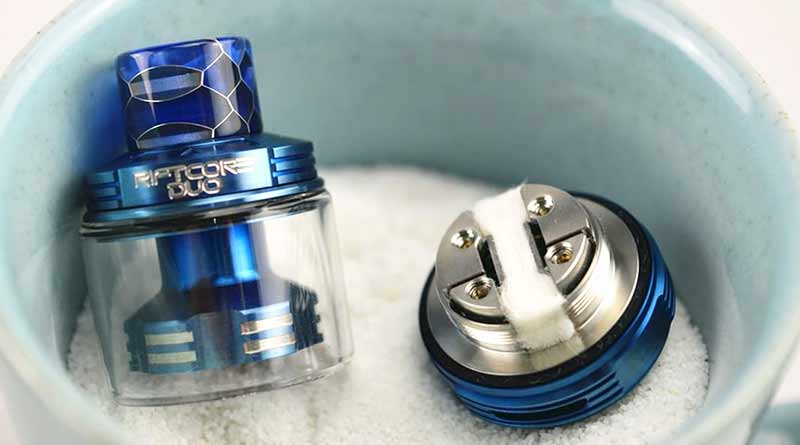
While this is another one that didn’t go nearly as expected, there’s a lot of ground to cover! …mostly because of some ‘recent developments’ while I was about to release my earlier write-up.
In fact, thanks to a certain video reviewer who seems to THRIVE on controversy (dying for views and attention), the potential of this atomizer to fill a very niche market segment, is being turned into quite the little “hornet’s nest” in a virtual circus sideshow where the net outcome in my opinion is trying to instill a lot of FUD into the community.
But before we delve into all the asides and potential issues, discrepancies, et al, I’m going to cover my original thoughts and experiences with this very unique RTA (though it’s actually more of a “ReWickable” Tank Atomizer as DJLsb referred to it.)
Unboxing and first impressions
It’s got a slim cover (on the left) that goes over the basic black primary box (on the right).
The box contains the usual spares etc, but ‘showcases’ the atty front and center.
Once you get to the meat and potatoes, it’s actually a quite striking (attractive) atomizer,
I oriented the 510 tip to show that the resin honeycomb design isn’t perfectly measured out around the outside, so this might annoy the most OCD out there… Also, incidently, the logo also does double duty as a ‘reminder’ for where the top fill point is! I thought this was a very nice touch on Joyetech’s part, and is something I appreciate.
If you push on the logo (using your thumb or forefinger) the top slides open into filling position smoothly, and stays firmly in place.
Filling can be a bit tricky for some I imagine if you’re not using a slim-tipped glass dropper, or a narrow tipped plastic bottle. But honestly, IMO, With the atomizer being more important than what you use to lug your e-liquid around in (at least in the DIY community), I don’t see it as an issue.
Disassembly
My first thought while disassembling was “Boy!! These threads feel a bit rough.”
But as it turns out, while they are coarse threads (size-wise), they are smoother than what they originally seemed. Due to the fact that the cotton was extending into the threads, and ‘skewing’ the feel of the connecting threads (cotton had to be thicker in some gaps than others, due to the rough cutting of the cotton during it’s installation). This is especially evident on the right side (by the positive post) of the photo below:
Once it the cotton was primed with e-liquid, things were a bit smoother to reassemble. Even smoother when it came time to pull it apart.
Even still, it could benefit from a slightly longer ‘lip’ on the male threads, because with the added resistance from the bottom o-ring, it’s imperative to make sure that you have the threads well-started, otherwise you risk cross-threading the deck/upper chamber assembly!
The 510 drip tip is tapered. Very tapered.
Nice and wide at the top, 10.69mm ID in fact, at the outermost edge of the inside.
But restricts to only 5.35mm at the intake (nearest the tip meets the chimney of the atty).
I’ll comment more on this soon in a comparison on 510 tip types. 
(I had some thoughts here, but upon re-reading, decided it didn’t belong, and it warrants it own ‘spotlight’ if you will)
There was a bit of what looked like scratches inside the upper chamber on first inspection, but a quick blow inside revealed that it was only “cotton dust”. As you can see in the right hand pic, most of it cleaned out just fine.
The chimney itself isn’t round, but does have a nice taper to it, helping to direct the airflow to the tip.
The Chamber and “deck”
At last!! The meat and potatoes!
Here’s where it starts to get interesting.
First things I notice:
- The flat cotton strips are wicked from side to side (on a vertical plane). Meaning not laying the strips in flat from top to bottom as some might not think about…but thoughtfully put into position in the way pressure should be ideally applied in my opinion: against the plates!
- The plates are kind of a dark color. Interesting.
- The airflow feed points are not evenly installed/manufactured. (Note how on the left, the full airflow channel ends almost directly and entirely underneath the RFC heater. On the right, you could fit a full second heater in the room that is offset.) This is almost certainly going to affect air-pathing, as well as how hot one RFC gets compared to the other.
- Also of interest to me, was the fact that the hex (allen-key) screws are almost completely stripped out on the positive portion. Obviously the build was done at two different points on the line, and the air pressure was different to the screwdrivers, the torque settings were different, or it was simply time for a new bit. At any rate, if Joyetech DOES release replacement RFC panels for this (unlikely IMO), it may prove to be difficult to deal with.
*How does it vape?
Well, here’s the thing…due to the difference in “coil” (plate) material, it takes forever to heat up (at a reasonable power level). Like almost 10 seconds at 35-45w.
BUT, if you put it on a quality mod in TCR mode, and adjust it to a TCR of 450, and then set it to your normal 30-40w, it comes alive MUCH quicker! And it’s a decent vape too! Granted, it’s a bit subdued compared to some (on flavor), but, for those who are absolutely fed up with buying inconsistent replacement cartridges that you screw in, or those who can’t manage the dexterity for dealing with installing pre-made/wrapped coils… This thing is an ideal alternative IMO.
A very small minority granted, but also a very (as yet) under-served minority, and I think it’s wonderful to see it beginning to be addressed!!
But TCR is a required mod function to use this atomizer effectively in my experience.
Aesthetics
A couple of obligatory shots to see what it looks like on a mod (Eleaf Istick Pico S on left, and Smoant Cylon on right):
The current “controversy” (concern for some)
The VERY first thing I’m going to say is that I DO NOT KNOW for certain how much of this is worth worrying about. Personally though, I wouldn’t jump on the hate-train until we get more FACTS. But that’s just me! There’s as much bad information, and assumptions (in my opinion) in Jai’s video, as there is that remains to be cleared up on Joyetech’s side (or at least about the material composition and testing of the RFC heaters).
But I leave this to you, the reader to make up your own mind about.
I’m just trying to combat bad information and assumptions with “things to think about” while looking over the information that I am attempting to provide. And I do so with as much of an open-minded and level headed viewpoint as I can muster.
Jai Haze video REEKS of sensationalistic clik-bait, with the especially “I dare you to click” title of WARNING Exposed & Dangerous Joyetech Riftcore Duo Review and Horrible Business Practices and Lies .
Joyetech still has a line in their current webpage that clearly states:
But the link to the US lab testing DOES NOT work. So e’s right on that account.
(While “MSDS Report” is clealy in blue, it’s not an actual working link currently.) But then they follow it up with the Chinese testing report from CPST.
Equally as few facts from Jai as what he’s railing on Joyetech about though in my opinion.
Jai makes the basic assertion of ‘it’s the same stuff’ with no proof or facts to back it up, other than what amounts to an assumption without offering any actual scientific testing (whether he paid to have it analyzed, or someone else did) to prove what he says is true. He instead references his prior NCR (New Concept RDA) by Nicotine Reinforcer video in which he compared the structure and materials of the NCR to the Guo Altus.
If you compare the shot (at 5:30 in his NCR video), the materials used in those two examples are decidedly lighter in color than what’s used in my RFC heaters (as shown below):
Even in that video, he refused to name his source for the claim. Even though the two appear to be very different styles of constuction. But in the least, they’re different external materials from one another. (Again, referencing the video time of 5:30 in…) The element on the left (Guo Altus -according to Jai) appearing to be a ceramic material laid over the top of the actual heating element (as is evident by the ‘core’ being visible about 5:39 where he shines the flashlight through it). Vs the one on the right (the NCR), where the internal construction, as well as external material remains unclear.
In my humble opinion (WARNING: NOT BASED ON FACT), the Altus appears to be different material than the NCR. Simply because, one is semi-see-through with a clearly visible heating element, and the other you can’t even see the element (although, because of the plated connection points, it’s still implied that there IS an embedded element). The RFC definitely does things differently from the Altus. But remains to be seen in my book as to the rest.
It could still very well be within the realm of possibility though that even with an embedded element (in the NCR), that they could have also intended to supplant the “element alone” approach, and add extra heat distribution through the surface area by using something other than “common ceramic”… At any rate, the NCR isn’t at issue here. I’m curious about whether or not the substrate and/or element is the same.
More confusing data
At any rate, even IF we accept the premise that the NCR is indeed Aluminum Nitride, it is decidedly different from it’s Altus predecessor.
But both of those are a different color than the material used on the RFC plates.
Noticing the color difference led to looking up info on Tungsten, and Aluminum Nitride.
Primarily because of the TCR vs power issues I was experiencing. I had to ramp to between 55w-65w to begin to get a decent vape in power mode, but by then, it was getting so hot that it was heating the liquid surrounding the chamber, that it was developing a burnt taste. So it was obvious that it was either get to temp quicker with a higher power (and risk burning the liquid), Use at a lower power and wait forever (but get the expected flavor profile). Or use in TCR mode, and get reasonable operation and matching the expectations of a familiar e-liquid.
So, while looking up TCR for AlN and Tungsten, I found that they can both reside in similar ‘profiles’
Tungsten is reported as 173W/(m-K).
Or, in TCR terms: 450.
Aluminum Nitride is shown at 70-180W/(m-K)
At least from this particular manufacturer’s datasheet (the supposed NCR material):
NOTE It’s worth mentioning, that Wikipedia (which I found later), shows a thermal conductivity for AlN of 285W/(m-K)
So. There’s conflicting data all over the place. Far too much for ME to leap to massive finger-pointing conclusions anyways…
(While I don’t know enough to know how to convert the following units, it’s easy to infer from the following pics, combined with the knowledge that Tungsten is accepted as residing in the TCR of 450 that they’re close to one another [AlN and Tungsten] that they could cause confusion as to the material used, BECAUSE OF the way they heat. So that could explain Jai’s confusion, but is still why, relying on FACTS especially in his position as a “trusted authority”, as opposed to knee-jerk assumptions.)
While he does have some interesting observations (missing US manufacturer data, and claims of US testing), the bottom line is, Joyetech DID have it tested by a testing authority in China.
CPST Testing Lab
Eurones (Dongguan) Consumer Products Testing Service Co., Ltd
One of Jai’s other complaints was about the phone number. The phone number that is listed (in the CPST MSDS sheet that Joyetech lists on their Riftcore page) IS a confirmed number (granted, by google-fu) belonging to, and historically tracked to CPST (who tested the RFC heater in China), but is an internet phone number (in other words, an IP address based phone number, and is portable) with a basis in the US.
Final thoughts
I’ll say this. I FULLY agree with Jai on ONE point: I think it’s of paramount importance that Joyetech provides the information pertaining to the claimed USA manufacturer (as well as lab tests corroborating the US lab testing) of the RFC heating elements. Not just to crush the “rumor factory” of all the FUD (fear, uncertainty, and doubt) that’s being created. But to have actual insight and trust earned to, by, and for their customers.
Joyetech dropped the ball on the way this was brought to market. Primarily because it’s a seemingly new technology (regardless of if it’s actually a rehash, or an actual improvement [be it in materials, or construction] of an older idea!)
“New” frequently equates to fear among some. But FACTS and CLARITY OF PROCESS will always help substantiate whatever the desired goal is.
I can’t say avoid it, because there’s not enough data for just cause IMO. But at the same time, as always is the case in marketing… Caveat Emptor. At least try and be an informed consumer!
All the best,
Sprks
(PS: I promise the next review won’t be REMOTELY as long winded!  )
)




